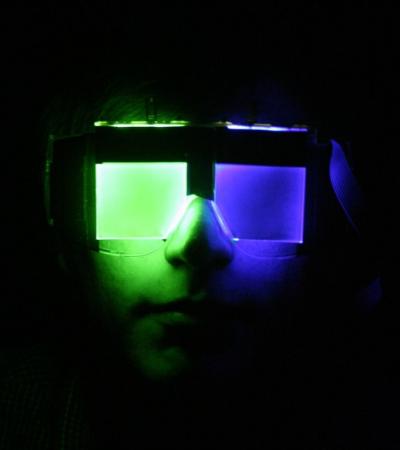A new study in Neuroscience Letters says that short-wavelength light, including natural light from a blue sky, is highly effective at stimulating the circadian system while exposure to other wavelengths — and thus colors — of light may necessitate longer exposure times or require higher exposure levels to be as effective at stimulating our biological clocks.
In some instances, exposure to multiple wavelengths (colors) of light simultaneously can result in less total stimulation to the circadian system than would result if either color were viewed separately, a phenomenon known as "spectral opponency." The LRC scientists have shown that the circadian system shares neurons in the retina — which exhibit spectral opponency and form the foundation for our perception of color — with the visual system. Thus, in principle, the circadian system may be able to distinguish between lights of different colors.
More than meets the eye To demonstrate that the circadian system exhibited spectral opponency formed in the retina, the researchers exposed 10 subjects to three experimental conditions: one unit of blue light to the left eye plus one unit of green light to the right eye; one unit of blue light to the right eye plus one unit of green light to the left eye; and half a unit of blue light plus half a unit of green light to both eyes and then measured each individual's melatonin levels, a natural indicator of the circadian clock.

Credit: Rensselaer/Lighting Research Center
"The first two conditions — exposure to a single color in each eye — did not result in a significant difference in melatonin suppression, while the third condition — exposure to both colors in both eyes — resulted in significantly less melatonin suppression," said Mariana Figueiro, lead author of the paper and assistant professor in the Lighting Research Center (LRC) at Rensselaer Polytechnic Institute. "Even though the amount of light at the eye was the same in all three conditions, when the two colors of light were combined in the same eye, the response of the system was reduced due to spectral opponent mechanisms formed in the retina."
This indicates that spectral opponency is a fundamental characteristic of how the human retina converts light into neural signals in the human circadian system, according to Figueiro.
The findings also verify the accuracy of a new quantification system LRC researchers developed in 2006 to calculate the "circadian efficacy" of different light sources. Called the model of human circadian phototransduction, the tool correctly predicted the circadian system response demonstrated under each of the three experimental conditions.
The model appears to correctly predict the circadian response to any light source, and can be used as the foundation for a new system of circadian photometry, much like the current system of photometry based on human vision.
Quantification of light as a stimulus for the circadian system provide new scientific insights into how the human body processes light for the circadian system, according to Figueiro.
Nocturnal melatonin, a hormone produced at night and under conditions of darkness, is used as a marker for the circadian clock. Scientific evidence suggests that disruption of the circadian system — and thus the melatonin cycle — may result in increased malignant tumor growth, as well as poor sleep quality, lack of alertness, seasonal depression, and immune deficiencies.
Now that the model can predict circadian efficacy for any light source, Figueiro and her research partners have begun studying the way time of night affects the potency of light exposure. Once complete, the comprehensive model will allow manufacturers to develop light sources that most effectively stimulate and, importantly, do not stimulate the circadian system.
Figueiro's research was supported by a $200,000 grant from the New York State Office of Science, Technology, and Academic Research (NYSTAR), which awarded her the James D. Watson Investigator award in 2007.
The Watson awards are designed to recognize and support outstanding scientists and engineers who show potential for leadership and scientific discovery early in their careers in the fields of biotechnology, according to Michael J. Relyea, executive director of NYSTAR.
Figueiro conducted her research with LRC Director Mark Rea, and Senior Research Scientist Andrew Bierman, who are coauthors on the paper.




Comments